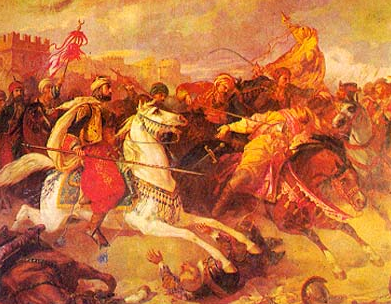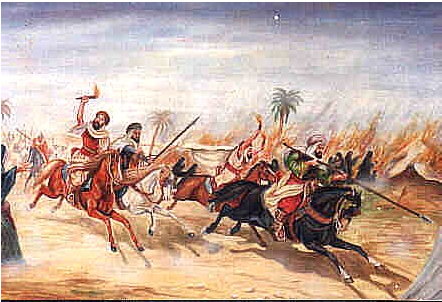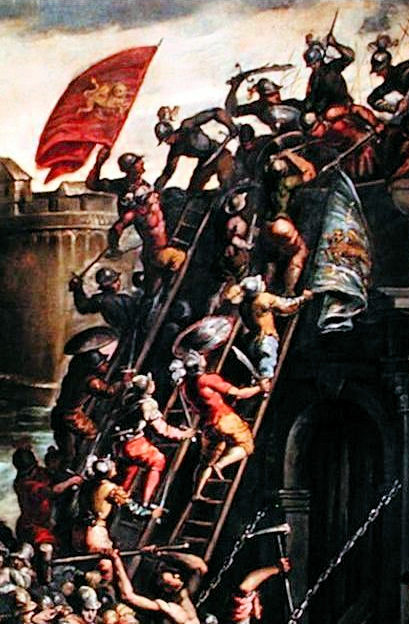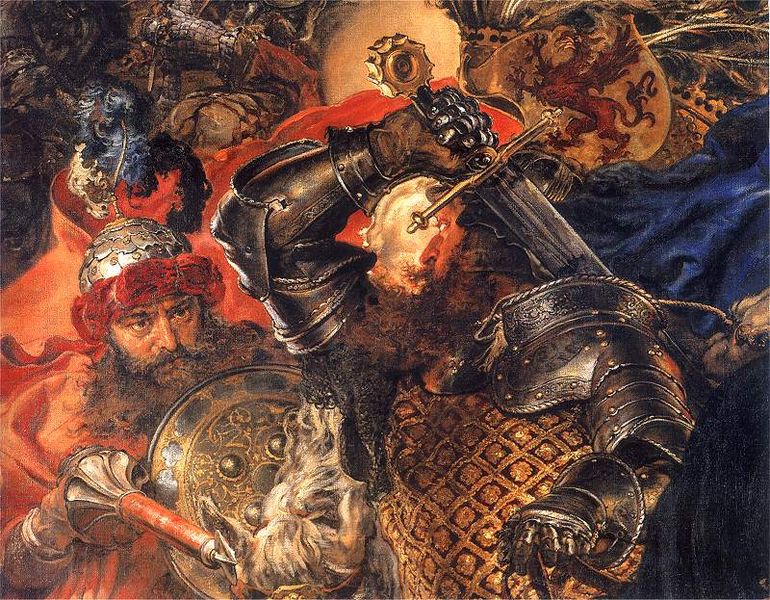When Muley Abul Hassan heard of the vast force that was approaching under the command of the Duke of Medina Sidonia, and that Ferdinand was coming in person with additional troops, he perceived that no time was to be lost: Alhama must be carried by one powerful attack, or abandoned entirely to the Christians.
A number of Moorish cavaliers, some of the bravest youth of Granada, knowing the wishes of the King, proposed to undertake a desperate enterprise, which, if successful, must put Alhama in his power. Early one morning, when it was scarcely the gray of dawn, about the time of changing the watch, these cavaliers approached the town, at a place considered inaccessible, from the steepness of the rocks on which the wall was founded; which it was supposed, elevated the battlements beyond the reach of the longest scaling-ladder. The Moorish knights, aided by a number of the strongest and the most active escaladores mounted these rocks, and applied the ladders without being discovered; for, to divert attention from them, Muley Abul Hassan made a false attack upon the town in another quarter.
The scaling party mounted with difficulty, and in small numbers; the sentinel was killed at his post, and seventy of the Moors made their way into the streets before an alarm was given. The guards rushed to the walls to stop the hostile throng that was still pouring in. A sharp conflict, hand to hand and man to man, took place on the battlements, and many on both sides fell. The Moors, whether wounded or slain, were thrown headlong without the walls; the scaling-ladders were overturned, and those who were mounting were dashed upon the rocks, and from thence tumbled upon the plain. Thus, in a little while the ramparts were cleared by Christian prowess, led on by that valiant knight Don Alonzo Ponce, the uncle, and that brave esquire Pedro de Pineda, nephew of the Marquess of Cadiz.
 The walls being cleared, these two kindred cavaliers now hastened with their forces in pursuit of the seventy Moors, who had gained an entrance into the town. The main party of the garrison being engaged at a distance resisting the feigned attack of the Moorish king, this fierce band of infidels had ranged the streets almost without opposition, and were making their way to the gates to throw them open to the army. They were chosen men from among the Moorish forces, several of them gallant knights, of the proudest families of Granada. Their footsteps through the city were in a manner printed in blood, and they were tracked by the bodies of those they had killed and wounded. They had attained the gate; most of the guard had fallen beneath their scimitars; a moment more, and Alhama would have been thrown open to the enemy.
The walls being cleared, these two kindred cavaliers now hastened with their forces in pursuit of the seventy Moors, who had gained an entrance into the town. The main party of the garrison being engaged at a distance resisting the feigned attack of the Moorish king, this fierce band of infidels had ranged the streets almost without opposition, and were making their way to the gates to throw them open to the army. They were chosen men from among the Moorish forces, several of them gallant knights, of the proudest families of Granada. Their footsteps through the city were in a manner printed in blood, and they were tracked by the bodies of those they had killed and wounded. They had attained the gate; most of the guard had fallen beneath their scimitars; a moment more, and Alhama would have been thrown open to the enemy.
Just at this juncture, Don Alonzo Ponce and Pedro de Pineda reached the spot with their forces. The Moors had the enemy in front and rear; they placed themselves back to back, with their banner in the center. In this way they fought with desperate and deadly determination, making a rampart around them with the slain. More Christian troops arrived, and hemmed them in; but still they fought, without asking for quarter. As their numbers decreased, they serried their circle still closer, defending their banner from assault; and the last Moor died at his post, grasping the standard of the prophet. This standard was displayed from the walls, and the turbaned heads of the Moors were thrown down to the besiegers.
Muley Abul Hassan tore his beard with rage at the failure of this attempt, and at the death of so many of his chosen cavaliers. He saw that all further effort was in vain; his scouts brought word that they had seen from the heights the long columns and flaunting banners of the Christian army approaching through the mountains. To linger, would be to place himself between two bodies of the enemy. Breaking up his camp, therefore, in all haste, he gave up the siege of Alhama, and hastened back to Granada; and the last clash of his cymbals scarce died upon the ear from the distant hills, before the standard of the Duke of Medina Sidonia was seen emerging in another direction from the defiles of the mountains.
When the Christians in Alhama beheld their enemies retreating on one side, and their friends advancing on the other, they uttered shouts of joy and hymns of thanksgiving, for it was a sudden relief from present death. Harassed by several weeks of incessant vigil and fighting, suffering from scarcity of provisions and almost continual thirst, they resembled skeletons rather than living men. It was a noble and gracious spectacle—the meeting of those hitherto inveterate foes, the Duke of Medina Sidonia and the Marquess of Cadiz. At the sight of his magnanimous deliverer the Marquess melted into tears; all past animosities only gave the greater poignancy to present feelings of gratitude and admiration. The late deadly rivals clasped each other in their arms and from that time forward were true and cordial friends.
Washington Irving, Chronicle of the Conquest of Granada (New York: G.P. Putnam’s Sons, 1893), pp. 64-68.
Short Stories on Honor, Chivalry, and the World of Nobility—no. 157







